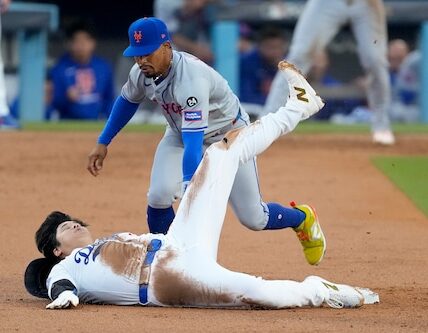The Mets’ Biggest Blunder in Game 2 Loss to the Brewers is a Lesson in Chaos Theory
One decision led to another in the New York Mets’ Game 2 loss to the Milwaukee Brewers, creating a snowball effect that ultimately cost them the game. The focus of blame may be on asking Phil Maton to pitch in the eighth inning, but the situation was more complex, illustrating how a series of managerial decisions can spiral out of control, leading to unintended consequences.
The Phil Maton Dilemma: A Symptom, Not the Cause
Maton’s appearance in the eighth inning wasn’t the root cause of the Mets’ downfall. Sure, after a groundout and a single by Willy Adames, pulling Maton might have seemed like a smart move. However, given the bullpen’s shorthanded state, one could argue that even an overused Maton was still a better option than the alternatives left in the Mets’ bullpen. The real issue began much earlier, with questionable decisions that left the bullpen depleted.
Sean Manaea: Pulled Too Early?
The decision to pull starting pitcher Sean Manaea after five innings and 86 pitches is where the true problem began. As John Harper pointed out, Maton was already struggling and giving up hard hits by the time he entered. But the bigger question is why Carlos Mendoza pulled Manaea so soon, especially when the bullpen was already short on reliable arms. Manaea, who had been performing well, could have saved the team from dipping too deep into their relievers.
Manaea was efficient, throwing strikes and managing the Brewers’ lineup well. There was no immediate threat of base stealing, and with just a few more pitches, he might have extended his outing into the sixth inning. That extra inning could have preserved the bullpen for later use, easing the burden on Maton and others.
Overusing the Bullpen: The Ripple Effect
By overusing Maton in the days leading up to the postseason, the Mets inadvertently set themselves up for failure. Maton had already thrown 15 pitches on Friday, another 23 on Saturday, and an additional 12 on Monday, leaving him far from fresh. Meanwhile, Edwin Diaz, who had pitched back-to-back days with 26 pitches on Sunday and another 40 on Monday, was no longer a viable option for more than three outs in Game 2.
The chaos didn’t end there. Relievers Reed Garrett and Ryne Stanek, who had thrown only 12 and 11 pitches respectively, were not given enough leeway. Instead, the Mets’ desire to give the bullpen a clean inning backfired, leading to poor results.
Offensive Woes Compound the Problem
While bullpen management played a significant role in the loss, the Mets’ offense was equally culpable. Going just 2 for 11 with runners in scoring position, the lineup failed to deliver in key moments. The team didn’t hit a single extra-base hit, and their small-ball style from Game 1, which helped score eight runs, was noticeably absent in Game 2. The Mets simply couldn’t find their rhythm at the plate, lacking the clutch hitting that could have turned the game around.
Moving Forward: Facing Elimination
Now, the Mets face a win-or-go-home situation in Game 3. While managerial decisions were a significant factor in their Game 2 loss, they were not the only reason for the defeat. The Mets’ offense, bullpen fatigue, and key mistakes all converged to create a chaotic scenario. If the team doesn’t address these issues and turn things around, they risk an early exit from the playoffs.
In the end, the Mets’ loss to the Brewers serves as a lesson in how a chain of decisions—starting with an early hook for Manaea and compounded by bullpen mismanagement—can unravel a game. Chaos theory at its finest.




